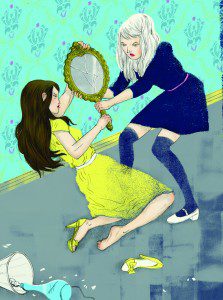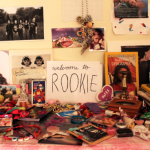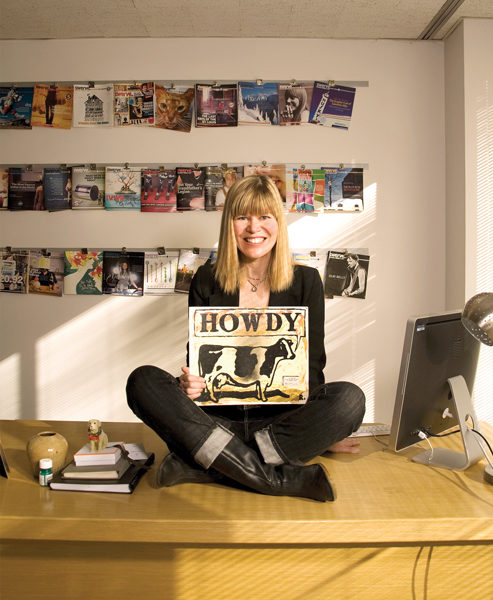Beauty and the brawl
Many journalists believe fashion and beauty books are easy targets for aggressive advertisers. But it’s a lot more complicated than that.
Beauty director Laura Fraioli-Keogh was working in her office at Fashion magazine when a publicist for a luxury beauty advertiser called. A major exclusive he had organized with Fraioli-Keogh had just hit newsstands, and he wasn’t happy. “How dare you put someone else’s product on my page!” he demanded. (An exclusive is an article that covers the launch of a new product or personality—in this case, it was the brand’s new “super-groovy” artistic director. One magazine is given priority access to the story and can cover it before its competitors.) “I had put one of the brand’s products that the makeup artist had used on the page, but when she went on to describe the things that she did, she had made mention of other products she used,” recalls Fraioli-Keogh. Naturally, she mentioned all the products used to create the look—not just those of the advertiser. Despite the publicist’s aggressive reaction, Fraioli-Keogh held firm: “It’s not anyone’s page but mine. Last time I checked, my card said Iwas beauty director.”
Well, yes and no—at least when it comes to fashion and beauty publishing. The fashion magazine industry has long been perceived as rife with “nudge-nudge, wink-wink” agreements that leave editorial content nearly devoid of journalistic credibility. However, this generalization doesn’t account for the complexities in the relationship between advertising and editorial. For editors at Canada’s mainstream fashion and beauty magazines, there are frequent pressures to cater to advertisers, especially where beauty is concerned. Like readers, for whom editors work first and foremost, advertisers are clients who need to be kept happy, says Rita Silvan, former editor-in-chief of Elle Canada. Fraioli-Keogh’s experience may have been more dramatic than other editors’, but it’s implicit when covering fashion and beauty. “The reader had better be your primary client,” Silvan says, but you’re also working for advertisers if you expect your magazine to survive.
The need for advertising support is hardly unique to fashion magazines. But while other magazines may have the occasional editorial quandary over a pushy advertiser, it would seem to be the norm in the fashion niche. That should raise red flags for all magazine editors: If advertisers feel comfortable muscling in on fashion books, how long will it take before they expect the same from everyone else? And though many product launches merit editorial attention in fashion and beauty magazines, at what point does coverage clash with credibility?
“No one ever says, ‘Listen, if you don’t cover this the way I want you to, we’re pulling our ads,'” says Ceri Marsh, former editor-in-chief of Fashion, “but people definitely let you know if they’re happy or not happy with the coverage they’re receiving.” Often, this comes in the form of a civilized phone call after an issue hits newsstands, but it’s not always that easy; boundaries are blurred, and advertisers sometimes forget that magazines are for readers—at least that’s how some editors see it. At Canadian fashion mags in particular, beauty departments feel the most pressure, because the beauty industry buys the most ads. “There would be no fashion magazine publishing in Canada without beauty advertisers,” says Marsh. “Fashion advertising is there, but it’s not the driver that the beauty industry is,” so the beauty editor is often on the receiving end of feedback from disgruntled advertisers. Fraioli-Keogh says that while she was working at Fashion, advertisers even put pie charts in front of her, critiquing her coverage of their brand, how she stacked up against other magazines, and where her deficiencies were. The fact that three corporations (L’Oréal Group, Estée Lauder, and Procter & Gamble) own many of the brands that advertise in fashion publications only further complicates matters (see page 52). “Estée Lauder owns everything,” says Diana Jackson (not her real name). “So if you don’t make Estée Lauder happy and you don’t make [Procter & Gamble] happy, it’s not good.”
Though Marsh says she’s never seen an advertiser threaten to pull out of a publication, it’s not entirely unheard of. “One time, we had an incident where it went so far that the company went to the chairman and they wanted to pull advertising across the board, for all of our books, based on a decision I made,” says Fraioli-Keogh. The situation involved a miscommunication around an exclusive; the advertiser felt it had been done wrong and was ready to cancel its ads in all St. Joseph Media’s publications, which include Toronto Life and Canadian Family, among others. “Exclusives are a tricky issue, and sometimes those things happen,” says Fraioli-Keogh. “You learn lessons, but sometimes the shit hits the fan. If you’re lucky, you’re supported by your editor-in-chief and your publisher, and everyone stands together and you say, ‘Okay, how do we want to address this?'”
Addressing the pressure can be difficult for editors, who have to juggle staying true to their magazines’ mandates with the demands and expectations of their advertisers. “In general, most consumer magazines have a policy of church and state that says advertising can’t sell directly based on editorial,” says Gwen Dunant, a longtime ad sales representative, president of Dunant Consulting, and professional development coordinator for Magazines Canada. In other words, a magazine ad salesperson should not offer a brand editorial coverage in return for an ad purchase. “You don’t want advertisers influencing the editorial in any way,” says Dunant, but advertisers expect the world from magazines, which can be a real challenge for editors. There tends to be more pressure on fashion magazines to give editorial coverage, Dunant says, because of the nature of fashion. The industry itself is very timely, and advertisers demand a synergy between ads and editorial content.
“The old theory of church and state”—that the journalistic side and the business side of a publication are completely separate—”has never been entirely true,” says Alan Middleton, a marketing professor at the Schulich School of Business at York University. Though an editor may never have to speak directly to an advertiser, she would absolutely be aware of who her advertisers are, and like Fraioli-Keogh, she would have to deal with the messages they project through their public relations agents. The relationship between advertising and editorial in fashion and beauty books doesn’t always come down to messages from advertisers and publicists, though; it can be internalized in the publications themselves, as a means of avoiding the possible consequences of displeasing the brands that pay the bills.
Pressure from advertisers in the fashion and beauty mag world is certainly not a secret, says Fraioli-Keogh, but many editors and staffers at Canada’s best-known fashion magazines refused to talk or did not reply to interview requests for this story. Some of those who did agree to speak asked to have their real identities hidden.
One was Diana Jackson. Three years after finishing her undergraduate degree in journalism, she got her first real magazine job: editorial assistant at a successful Toronto-based women’s book with heavy beauty content. When someone from the sales staff asked her to go through each issue and count how many times, and on which editorial pages, particular brands had been mentioned, she thought it was strange. When she realized why she was doing it—the publisher was using the information to pull in advertising from particular brands—she was dismayed. But then her editor told her their content was fluff anyway, and one of the magazine’s most influential stylists said to her, “We ain’t saving babies, so we might as well have fun!”
A few years into Jackson’s career at the magazine, she was asked to work on the beauty pages for a spinoff of a major fashion book. “So, you only have six negotiated pages,” said her editor in their first meeting. A negotiated page, Jackson soon learned, is a story based entirely on advertiser spending. She was expected to write a piece about an advertiser’s spring makeup line. “It was brutal,” she says. “I didn’t go to journalism school to write public relations.”
Jackson was surprised again when she found out that the products used in beauty stories aren’t always the ones the magazines claim they are. Jennifer Smith (a pseudonym), who has done makeup for Fashion, the short-lived Fashion 18, Weddingbells, Glow, and Canadian Living, among other titles, says that beauty editors have given her specific makeup to use, with the direction, “This is a major advertiser in this issue, so we need to cover their brand as best we can.” Particularly in the past, if the makeup supplied wasn’t right for a shoot, Smith might get the go-ahead to match the colour to something from her own kit. Whether the editor credited the product correctly had nothing to do with her, she believes. “I’ve definitely done shoots where they’ve credited who their major advertisers are [instead of] what I’ve used,” she says, although she notes that this is not happening as often as it used to. Ultimately, Smith says it comes down to advertising dollars, “but I can’t really answer as far as a magazine is concerned,” she says, “because after I’ve done my job, it’s up to them to credit accordingly.”
There’s a pressure to cover advertisers because “advertising has a certain credibility,” says Middleton, “but it isn’t as high as if somebody who is not commercially paid to endorse a product says it’s really good.” When a publicist for a major advertiser continually asks an editor to showcase its products, it can be particularly difficult for an editor to say no—especially when everything she needs to produce a quality story is laid out in front of her in a pretty package. Publicists—particularly those who represent top-tier brands with big budgets for public relations and advertising—offer editors access to interview subjects, beautiful photographs, possible story angles, and invitations to all-expenses-paid press trips where they introduce their products. It would be difficult for an editor to create a well-rounded story without these things, and publicists are well aware of this. “There are fantastic people working in that business, on the publicist side, who work really hard with you to come up with a great story and offer you something exclusive and something special,” says Marsh, “so you think, yeah, that’s great, I want to publish that. And then there are some people who aren’t so diplomatic, who kind of bully you.” As an editor-in-chief, you’re closer to the business side of your publication than anyone else on your editorial team, so you know how your magazine is doing, says Marsh. “If you care about your publication, it’s difficult not to be influenced by [pressure from advertisers and publicists] and to want your magazine to be financially robust.”
“I think everyone understands that there is a give and a take,” says Fraioli-Keogh. “I always looked at it as a partnership, that we needed each other.” As Virginie Mouzat, fashion critic for the French daily Le Figaro, said in an interview last year in Industrie magazine, “The moment the word ‘need’ comes into the equation, the argument becomes distorted.” Like Fraioli-Keogh, Mouzat thinks advertisers should be seen as partners, not demons. “From the moment they’re partners, you work with them,” she says, “but that doesn’t mean working for them. Working together is like being in a couple: you discuss things, you have arguments, you agree, you disagree, but you make your progress together.”
Marsh and Silvan see it the same way. In the fashion and beauty realm, knowing who your advertisers are and working to live up to their expectations are just part of the territory. Marsh says she doesn’t believe that what goes on is in any way nefarious, and that advertisers have every right to feel they should be covered. “They’ve got products coming out; they’ve got stories to tell,” she says. “The readers of a fashion magazine want to know that—they want to know what’s new. In a lot of ways, it’s as it should be.”
Regardless of advertiser demands, editors feel that they alone have the final say on what gets published. “You can try to push me in directions that you want me to go in,” says Fraioli-Keogh, “but at the end of the day, my creativity is going to find a way out of those boxes. I had to engineer a way to make a story that was credible and relatable, and that would make sense to the reader I was speaking to. I just think there’s a way to report even within the confines of an exclusive. I was told lots of times, ‘We want you to write a story about this product and these are the only pictures you can use,’ and it was my job to make that page and that story relatable and make sense to the reader I was talking to. I pushed back, and you have the ability to do that.
“I wasn’t shackled,” she says. “I didn’t allow myself to be shackled. For sure, there are moments when they push back at you and you feel the pressure, and that’s what makes a good editor—someone who can walk that line.”
Photograph of Ceri Marsh and Laura Fraioli-Keogh by Jessica Blaine Smith.
Stephanie Fereiro was the Chief Copy Editor of the Summer 2012 issue of the Ryerson Review of Journalism.














































